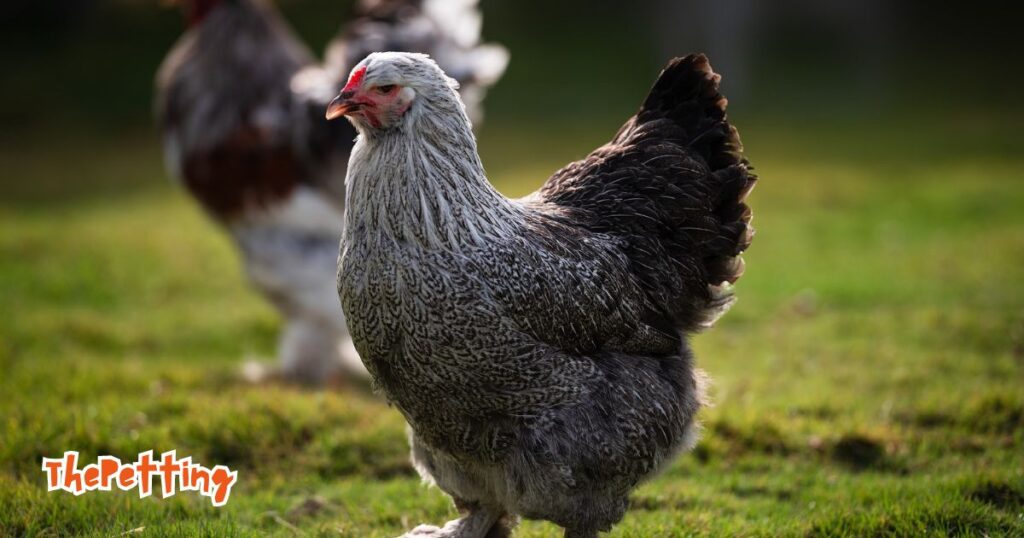Introduction
Brahma chickens, known for their large size and gentle temperament, are a unique breed that requires specific nutritional care to thrive. Whether you’re raising Brahmas for eggs, meat, or as show birds, providing them with a balanced diet is essential for their health and productivity. In this guide, we’ll explore everything you need to know about feeding and nutrition for Brahma chickens.
Read more about Chicken’s Feed

Understanding Brahma Chickens
What Are Brahma Chickens?
Brahma chickens are a large breed known for their impressive size, feathered legs, and calm demeanor. Originating from Asia, these birds are valued for their dual-purpose qualities, producing both eggs and meat. They are also popular in poultry shows due to their striking appearance.
Nutritional Needs of Brahma Chickens
Due to their large size and specific breed characteristics, Brahma chickens have distinct nutritional needs. They require a balanced diet to maintain their health, support growth, and ensure optimal egg production.
Basic Nutrition for Brahma Chickens
Essential Nutrients
- Protein: Vital for growth, muscle development, and egg production. Brahmas need a higher protein content compared to some other breeds.
- Carbohydrates: Provide energy for daily activities and overall health.
- Fats: Essential for energy and maintaining healthy feathers and skin.
- Vitamins and Minerals: Crucial for overall health, bone development, and egg production. Key vitamins include A, D, E, and B-complex, while important minerals include calcium, phosphorus, and salt.
Types of Feed
- Starter Feed: For chicks up to 8 weeks old, rich in protein to support rapid growth.
- Grower Feed: For young Brahmas from 8 weeks to 18 weeks, with moderate protein to support continued growth.
- Layer Feed: For laying hens, high in calcium to support strong eggshells.
Feeding Brahma Chickens
Feeding Schedule
- Chicks: Feed starter feed continuously, with access to fresh water.
- Growers: Transition to grower feed at 8 weeks, adjusting feed amounts based on growth and activity levels.
- Layers: Switch to layer feed once they start laying eggs, typically around 18-20 weeks of age.
Amount of Feeding
- Chicks: Offer 1/4 to 1/2 cup of starter feed per chick per day.
- Growers: Provide 1/2 to 1 cup of grower feed per chicken per day.
- Layers: Supply 1 cup of layer feed per chicken per day, adjusting for individual needs.
Water Supply
Always ensure your Brahmas have access to clean, fresh water. Proper hydration is crucial for digestion and overall health.
Special Dietary Considerations
Feeding for Egg Production
- Calcium Needs: Laying Brahmas require extra calcium for strong eggshells. Provide crushed oyster shell or limestone as a supplement.
- Protein Levels: Ensure a higher protein diet during the laying period to support egg production.
Winter Feeding
During colder months, Brahmas may need additional calories to maintain body heat. Increase the amount of feed slightly and consider adding warm treats or mash.
Common Feeding Mistakes to Avoid
Overfeeding
- Risk of Obesity: Overfeeding can lead to obesity, especially in a breed as large as the Brahma. Monitor their weight and adjust feed portions accordingly.
Feeding Inadequate Diet
- Nutritional Imbalance: Avoid feeding only scratch grains or other incomplete diets. Ensure that the feed provides a balanced mix of nutrients.
Ignoring Water Needs
- Hydration Issues: Always provide clean, fresh water. Lack of hydration can lead to health issues and decreased egg production.
Supplements and Treats
Healthy Treats
- Variety: Offer healthy treats such as vegetables, fruits, and grains. Avoid sugary or salty snacks.
- Moderation: Treats should make up no more than 10% of their diet to prevent nutritional imbalances.
Supplements
- Probiotics: Adding probiotics can help with digestion and overall gut health.
- Electrolytes: Use electrolyte supplements during stressful times, like extreme weather or illness.
Feeding Brahma Chickens for Show
Appearance and Health
- Feather Quality: High-quality feed supports the growth of healthy feathers and a shiny coat, which is important for show birds.
- Health Management: Regularly monitor their health and adjust their diet to maintain their condition for show standards.
Conclusion
Feeding Brahma chickens properly is essential for their health, productivity, and overall well-being. By providing a balanced diet tailored to their specific needs, you ensure that your Brahmas will thrive, whether they are being raised for eggs, meat, or as show birds. Regularly review their diet and make adjustments as needed to keep them in top condition.
FAQs
1. What type of feed is best for Brahma chicks?
Brahma chicks should start with a high-protein starter feed to support their rapid growth and development.
2. How often should Brahma chickens be fed?
Brahma chickens should be fed daily with a consistent feeding schedule, providing the appropriate feed type for their age and stage.
3. How can I ensure my Brahma chickens get enough calcium?
Provide layer feed with added calcium and offer crushed oyster shells or limestone as a supplement to ensure strong eggshells.
4. Can Brahma chickens eat treats?
Yes, Brahma chickens can eat treats, but they should be healthy and given in moderation, with treats making up no more than 10% of their diet.
5. What should I do if my Brahma chickens are overweight?
Adjust their feed portions and ensure they are not overfed. Increase their exercise opportunities and monitor their weight regularly.
